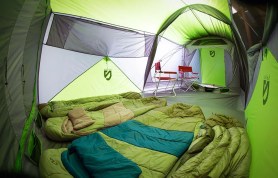

If you’re lost or in a survival situation, being able to read the weather from nature’s signals helps with many things, such as knowing whether to move or stay put and when to prepare to take shelter or collect rainwater. In his years in the UK Special Forces Reserves, as well as a survivalist, Bear Grylls has learned to read all types of weather and what it means, depending on the terrain he is in.
Videos by Outdoors with Bear Grylls
“In the desert, another baking day will definitely not be the time to move but rather to hole up, whereas in the mountains it may well be the time to go,” he says in Born Survivor.
However, if you see a distant storm in the desert, this might be a good source for water, or if the weather looks like it is changing in the mountains, it might be a good idea to find shelter sooner. Bear and his crew have often had to deal with bad weather while filming shows like Running Wild, keeping crew, equipment and celebrities out of danger.
“Predicting bad weather in the short term is not rocket science,” says Bear. “When the omens look bad—dark clouds, thunder in the distance, gusting wind in advance of rain—they usually mean just that and you should take precautionary measures.”

Analyze the clouds
The best signs of weather are clouds, which can predict long-term changes up to six hours away. Being able to recognize the different types of clouds and their meanings can be very useful.
“A good tip I was told whilst with the SAS was that clouds tend to behave as they look,” Bear says. In other words, if they look bad or benign they probably are.”
Predicting the weather is not an exact science, but knowing the different cloud types and what kind of weather they might be ‘likely’ to bring is very useful. There are three categories of height for clouds.
High clouds that at 16,000 to 46,000 feet are “cirrus” clouds and/or use the prefix “cirro.” Cirrus clouds look like thin, wispy streaks or “mare’s tails” and can mean fine weather, then rain. Cirrocumulus, which can look like a “mackerel sky” or rippled sand, can mean showers, while cirrostratus, an amorphous, continuous cloud, indicates rain.
Medium-height clouds at 6,500 to 16,000 feet use the prefix “alto.” Altocumulus appears as a dimpled, heaped cloud and could indicate showers, while altostratus, producing a “watery sun,” indicates steady rain.
Low clouds below 6,500 are called stratus, or use the prefix “strato.” Stratocumulus, a heaped layer cloud, means no change in weather. A stratus-amorphous layer cloud means drizzle, and nimbostratus—a layered cloud, stacked high—means a storm. Low clouds that indicate good weather include puffy, fluffy cumulus clouds; while cumulonimbus, a fluffy cloud heaped very high, indicates a thunderstorm.

Learn the crossed-winds rule
The behavior of wind is another way to predict weather changes. As fronts pass through, they produce changes in atmospheric pressure. This causes the wind to change direction.
In the northern hemisphere, when clouds are medium to high in the sky, stand with your back to the wind. If the high clouds are coming from the left, the weather is likely to get worse. If the high clouds are coming from the right, the weather is likely to improve.
This rule is revised in the southern hemisphere.
Beware of lightning strikes
The danger in a thunderstorm is being hit by lightning. When a lightning bolt hits the ground, it passes an electric current through everything in the immediate vicinity, so make sure that this is not you.
“If you have time, find shelter on lower ground at once and keep well away from open ground, single trees, or large rocks which may attract the strike,” says Bear.
Sit on something dry that will not conduct the current—a climber’s rope or even wood—and curl up in the fetal position with your arms around your legs, and your feet off the ground, to ensure minimal contact with the ground. Also keep away from any metal like trekking poles and remove your watch or any jewelry.
If you’re taking shelter in a cave or under a rocky overhang, don’t stand near the entrance, as the current can spark across the opening.










